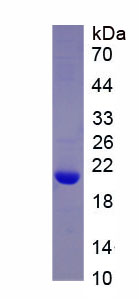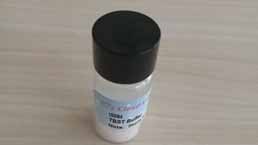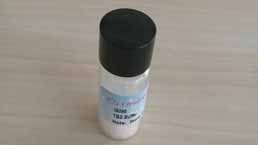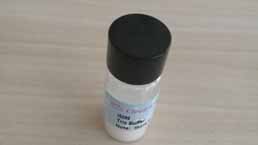Active Endostatin (ES) 

- UOM
- FOB US$ 252.00 US$ 630.00 US$ 1,260.00 US$ 3,780.00 US$ 9,450.00
- Quantity
Overview
Properties
- Product No.APA542Hu61
- Organism SpeciesHomo sapiens (Human) Same name, Different species.
- ApplicationsCell culture; Activity Assays.
Research use only - DownloadInstruction Manual
- CategoryTumor immunityCardiovascular biology
- Buffer FormulationPBS, pH7.4, containing 5% Trehalose.
- Traits Freeze-dried powder, Purity > 90%
- Isoelectric Point9.1
Sign into your account
Share a new citation as an author
Upload your experimental result
Review

Contact us
Please fill in the blank.
Activity test
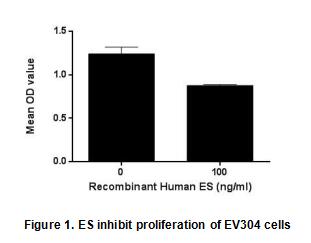
Endostatin (ES) is a naturally occurring, 20kDa C-terminal fragment derived from type XVIII collagen. It is reported to serve as an anti-angiogenic agent, similar to angiostatin and thrombospondin. Endostatin is a broad-spectrum angiogenesis inhibitor and may interfere with the pro-angiogenic action of growth factors such as basic fibroblast growth factor (bFGF/FGF-2) and vascular endothelial growth factor (VEGF). To test the effect of ES on inhibit the VEGF basic-dependent proliferation of ECV304 endothelium cell line, cells were seeded into triplicate wells of 96-well plates at a density of 5, 000 cells/well when the cell attached, replaced with serum-free standard DMEM overnight. Then the medium was replaced with 2% serum standard DMEM which contain 10ng/mL of VEGFA and various concentrations of ES. After incubated for 72h, cells were observed by inverted microscope and cell proliferation was measured by Cell Counting Kit-8 (CCK-8). Briefly, 10µL of CCK-8 solution was added to each well of the plate, then measure the absorbance at 450nm using a microplate reader after incubating the plate for 1-4 hours at 37℃. The result was shown in Figure 1. It was obvious that ES (100ng/mL) significantly inhibit cell proliferation of EV304 cells.
Usage
Reconstitute in ddH2O to a concentration of 0.1-0.5 mg/mL. Do not vortex.
Storage
Avoid repeated freeze/thaw cycles. Store at 2-8°C for one month. Aliquot and store at -80°C for 12 months.
Stability
The thermal stability is described by the loss rate. The loss rate was determined by accelerated thermal degradation test, that is, incubate the protein at 37°C for 48h, and no obvious degradation and precipitation were observed. The loss rate is less than 5% within the expiration date under appropriate storage condition.
Increment services
Citations
- Endostatin gene therapy enhances the efficacy of IL-2 in suppressing metastatic renal cell carcinoma in miceSpringerLink: u38777121t6660l5
- Erythrocyte Protoporphyrin Fluorescence as a Biomarker for Monitoring Antiangiogenic Cancer TherapySpringerLink: 4v306130302257w0
- Endostatin- and interleukin-2-expressing retroviral bicistronic vector for gene therapy of metastatic renal cell carcinomaWiley: source
- Endostatin neoadjuvant gene therapy extends survival in an orthotopic metastatic mouse model of renal cell carcinomaScienceDirect: S075333221100151X
- Antiangiogenic Activities of Cinnamon, Black and Green Tea Extracts on Experimentally Induced Breast Cancer in RatsScialert: Source
- Inflammation Induced by MMP-9 Enhances Tumor Regression of Experimental Breast CancerPubMed: PMC3619527
- Promotion of adipogenesis by an EP2 receptor agonist via stimulation of angiogenesis in pulmonary emphysemaPubmed:24911647
- Endostatin and kidney fibrosis in aging: a case for antagonistic pleiotropy?Source
- Angiogenesis inhibitor endostatin protects mice with sepsis from multiple organ dysfunction syndromePubMed: 26125086
- Endothelial Dysfunction and Nailfold Videocapillaroscopy Pattern as Predictors of Digital Ulcers in Systemic Sclerosis: a Cohort Study and Review of the LiteraturePubMed: 26142066
- Peripheral vasculopathy in Raynaud phenomenon: Vascular disease biomarkersscience:S1646706X16300052
- Impaired angiogenesis as a feature of digital ulcers in systemic sclerosisPubmed:26920752
- Blood biomarker for early blood brain barrier disruption in ischemic strokepatent:US20170199205A1





